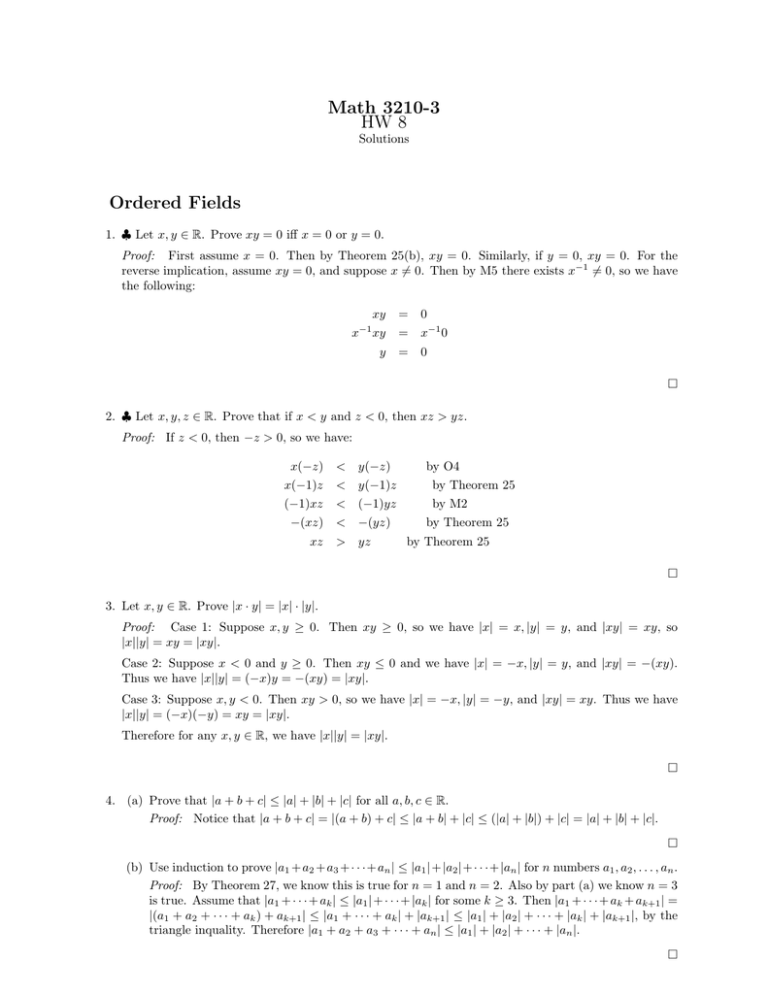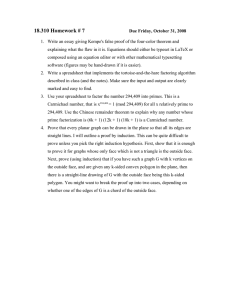Math 3210-3 HW 8 Ordered Fields
advertisement

Math 3210-3 HW 8 Solutions Ordered Fields 1. ♣ Let x, y ∈ R. Prove xy = 0 iff x = 0 or y = 0. Proof: First assume x = 0. Then by Theorem 25(b), xy = 0. Similarly, if y = 0, xy = 0. For the reverse implication, assume xy = 0, and suppose x 6= 0. Then by M5 there exists x−1 6= 0, so we have the following: x −1 xy xy = = 0 x−1 0 y = 0 ˜ 2. ♣ Let x, y, z ∈ R. Prove that if x < y and z < 0, then xz > yz. Proof: If z < 0, then −z > 0, so we have: x(−z) < y(−z) x(−1)z (−1)xz < y(−1)z < (−1)yz −(xz) < −(yz) xz > yz by O4 by Theorem 25 by M2 by Theorem 25 by Theorem 25 ˜ 3. Let x, y ∈ R. Prove |x · y| = |x| · |y|. Proof: Case 1: Suppose x, y ≥ 0. Then xy ≥ 0, so we have |x| = x, |y| = y, and |xy| = xy, so |x||y| = xy = |xy|. Case 2: Suppose x < 0 and y ≥ 0. Then xy ≤ 0 and we have |x| = −x, |y| = y, and |xy| = −(xy). Thus we have |x||y| = (−x)y = −(xy) = |xy|. Case 3: Suppose x, y < 0. Then xy > 0, so we have |x| = −x, |y| = −y, and |xy| = xy. Thus we have |x||y| = (−x)(−y) = xy = |xy|. Therefore for any x, y ∈ R, we have |x||y| = |xy|. ˜ 4. (a) Prove that |a + b + c| ≤ |a| + |b| + |c| for all a, b, c ∈ R. Proof: Notice that |a + b + c| = |(a + b) + c| ≤ |a + b| + |c| ≤ (|a| + |b|) + |c| = |a| + |b| + |c|. ˜ (b) Use induction to prove |a1 + a2 + a3 + · · ·+ an | ≤ |a1 |+ |a2 |+ · · ·+ |an | for n numbers a1 , a2 , . . . , an . Proof: By Theorem 27, we know this is true for n = 1 and n = 2. Also by part (a) we know n = 3 is true. Assume that |a1 + · · · + ak | ≤ |a1 | + · · ·+ |ak | for some k ≥ 3. Then |a1 + · · · + ak + ak+1 | = |(a1 + a2 + · · · + ak ) + ak+1 | ≤ |a1 + · · · + ak | + |ak+1 | ≤ |a1 | + |a2 | + · · · + |ak | + |ak+1 |, by the triangle inquality. Therefore |a1 + a2 + a3 + · · · + an | ≤ |a1 | + |a2 | + · · · + |an |. ˜ 5. ♣ Prove that in any ordered field F , a2 + 1 > 0 for all a ∈ F . Conclude from this that if the equation x2 + 1 = 0 has a solution in a field, then that field cannot be ordered. (Thus, it is not possible to define an order relation on the set of all complex numbers that will make it an ordered field.) Proof: Let F be an ordered field. First notice that if a < 0, then by problem 2, a · a > a · 0 = 0. Also, if a > 0, then by O4, a · a > 0 · a = 0. In either case, a2 > 0, so a2 + 1 > 0. Finally, if a = 0, then a2 = 0, so a2 + 1 = 1 > 0. Now assume we have an ordered field F in which there is some x ∈ F such that x2 + 1 = 0. Then x2 + 1 = 0 and x2 + 1 > 0, which implies that 0 > 0, a contradiction. So any field with a solution to x2 + 1 = 0 can not be an ordered field. ˜


